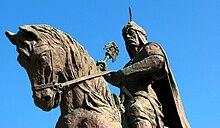Kai Kobad I.
Ala ad-Din Kai Kobad I. ( Persian علاء الدين كيقباد, DMG ʿAlāʾ ad-Dīn Kai-Qubād , New Turkish Alaeddin Keykubad ; † 1237 ) was Sultan of the Rum Seljuks from 1220 until his death . He followed his brother Kai Kaus I. by. Under him the sultanate became the most powerful empire in the region.
Family and youth
Kai Kobad I. was the second son of Kai Chosraus I. At a young age he was awarded the title of Malik. Kai Kobad I. ruled the city of Tokat as prince . When his father died in 1211, Kai Kobad I. and his older brother Kai Kaus I. fought over the successor. Kai Kobad I. initially received support from the rulers Leo II of Lesser Armenia and the Toghril Shah of Erzurum . But his brother was supported by most of the emirs and the rural aristocrats, so that Kai Kobad I lost the fight and the throne and fled to Ankara . He was later captured by his brother and imprisoned in a fortress in Western Anatolia. After the sudden death of his brother in 1220, he became the new sultan.
Campaign to Cilicia
After his accession to the throne , he undertook his first campaign to Cilicia in the south. There were strategic and economic reasons behind this campaign. So he wanted to open up the Mediterranean trade to the Seljuks. Coming from Antalya , he besieged the castle of Kalonoros by land and sea . Here the small Armenian nobleman Kyr Vart (also Kir Fard) ruled . He held his strong castle against the Seljuk siege for a long time. When he discovered that the fortress could no longer be held, he negotiated a peaceful surrender. In an agreement, Kyr Vart in the vicinity of Konya- Akşehir was granted five villages. Kai Kobad I. married Kyr Vart's daughter Hunat Hatun. She was later buried in Kayseri in the Hunat-Hatun complex.
Sultan Kai Kobad I. gave the conquered Kalonoros his name and called it Alaiyya ( ʿAlāʾiyya , today Alanya ). Alaiyya flourished during the reign of Kai Kobad I. The sultan rebuilt the city almost entirely and used it as a winter residence. The Alara Han caravanserai near Alanya was also built on his orders. He settled scientists and artists and thus made this old pirate town into a capital in a short time, in which culture, trade and science flourished. A number of merchants were also given concessions. Precious stones, gold, silver and grain could be imported duty-free. Only a small tax was levied on other imports. The most important goods Alanya sold to merchants from Venice , Genoa and Florence were spices, linen and sugar. Cedar wood was also a popular export item, particularly to Egypt. With the death of Kai Kobad I, Alaiye's heyday also came to an end.
Other conquests
After he was successful in the south, Kai Kobad I started military campaigns north against the Empire of Trebizond on the Black Sea . Under his emir Chupan, a sea expedition reached the Crimea and established a protectorate over the city of Sudak . In the east he profited from disputes among the local princes and thus conquered the possessions of the Saltukids to the right of the Euphrates . In 1228 he conquered Erzincan and ended the beylik of the Mengücek . Erzincan was handed over to his son and later successor Kai Chosrau II . On his way east he captured the fortresses Adıyaman , Kâhta and Çemişgezek . When the Khorezm Shahs invading Anatolia took the important city of Ahlat , Kai Kobad I was forced to ally himself with his rivals, including the Ayyubids , against the Khorezm Shahs. In 1230 he defeated the Khorezm Shahs under their last ruler Jalal ad-Din in the battle of Yassı Çemen . But now Kai Kobad I and the Ayyubids were facing each other. In 1233 Kai Kobad I repulsed an invasion of the Ayyubid al-Kamil from Syria . In 1237 Kai Kobad I died and the sultanate began to fall apart. His son lost to the Mongols from Iran and the sultanate became a vassal of the Ilkhan .
buildings
In addition to the almost complete rebuilding of the city of Alaiye, he left behind other buildings. There are the Alaeddin Mosque (Alâeddin Camiî) in its capital Konya , the Keykubadiye Palace in Kayseri and the Kubadabad Palace on Lake Beyşehir . Kai Kobad I. also had many caravanserais (trading posts and rest stops) built.
source
- Claude Cahen: Kaykubad . In: The Encyclopaedia of Islam. New Edition .
| predecessor | Office | successor |
|---|---|---|
| Kai Kaus I. |
Sultan of Rum 1220–1237 |
Kai Chosrau II. |
| personal data | |
|---|---|
| SURNAME | Kai Kobad I. |
| ALTERNATIVE NAMES | Alaeddin Keykubad; Kai Kobād I .; Allā ud-Dīn Key-Qobād |
| BRIEF DESCRIPTION | Sultan of the Rum Seljuks |
| DATE OF BIRTH | 12th century or 13th century |
| DATE OF DEATH | 1237 |

